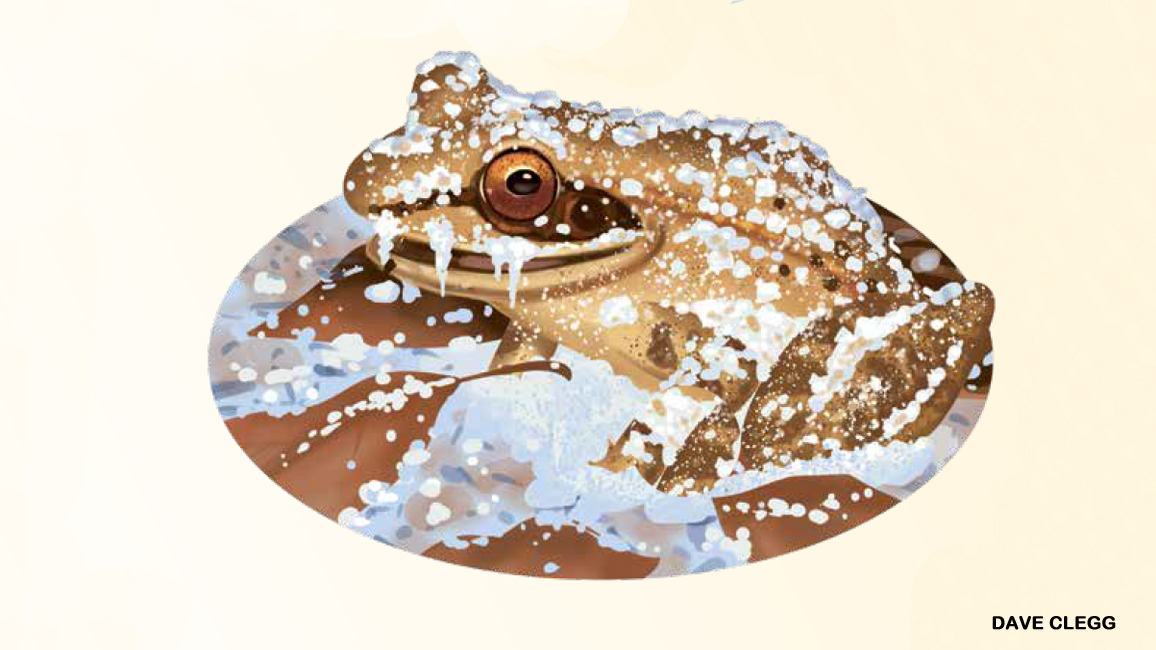
Winter Warriors
By Anne Cissel; Art by Dave CleggFind out how these tough creatures conquer the cold.

STEALTHY STASHERS
When winter comes, finding food can be a tricky business for wild animals. Some animals have solved this problem by gathering and storing food before winter comes.
Have you ever seen a squirrel running around with a nut in its mouth? It may be about to bury that treat in the ground, saving it for later. Luckily, squirrels have good memories and a sharp sense of smell to help them find their stash again. Black-capped chickadees also hide food, usually seeds, as they get ready for winter. Later, when it gets cold, the birds remember where all their snacks are hidden. But they have another trick: They grow new brain cells before winter to help them remember all their hiding places. In the spring, when food is plentiful, they don’t need to be as brainy!
FANTASTIC FEATHERS
Winter isn’t a big problem for birds. Feathers are their secret weapon against the cold. They fluff their feathers up, trapping pockets of body-heated air in between them. The air gives the birds an extra layer of protection against the cold. Underneath a bird’s outer feathers are soft, fluffy feathers called down. These feathers are especially good at trapping and holding body heat.
All birds have down, but the eider (a sea duck) has the warmest down of all. And this down does more than keep the eiders warm. In the spring, a mother eider plucks these feathers from her chest to line her nest. That’s a good thing, because she lays her eggs in the chilly Arctic region.

BARELY BREATHING
While some animals are hibernating, others—such as reptiles and amphibians—are brumating. Just as with hibernating animals, the bodies of brumating animals slow way down.
When a painted turtle decides to tuck itself away for the winter, it rests in the mud at the bottom of a pond or lake. But turtles have lungs and breathe air, so how can a painted turtle survive all winter underwater? Because its body is on pause, the turtle needs less oxygen. Its skin takes in enough oxygen from the water to keep the turtle alive. If there is hardly any oxygen in the water, the turtle can STILL survive for quite a while. How? Chemicals in its body work together with its cells to keep the reptile alive for months without oxygen. That’s turtle-y amazing!
STAYING STILL
Some animals survive the cold by finding a sheltered hideaway and taking lots of long naps. But only a few types of animals go into a special kind of deep sleep called hibernation. When an animal hibernates, three things happen: Its body temperature lowers, its breathing slows, and it burns energy much more slowly. That way, it can go a long time without food or water.
Before settling down for this kind of winter sleep, animals eat as much as they can to pack on the fat. Then they find a safe spot to hunker down. The arctic ground squirrel hibernates up to seven months in its cozy burrow beneath the snow. That’s one of the longest hibernations of any animal on Earth! During this time, its body temperature can drop below freezing.
CAREFUL COLORS
Staying warm and finding food are important, but so is not getting eaten! Many animals also have to worry about predators in the winter. Some mammals, such as the arctic hare, grow fur coats that are as white as the snowy world they live in. That makes it hard for a hawk, a wolf, or another enemy to see them. But how does it work? When the days start to get shorter, the animals’ bodies can tell there is less light. This triggers them to shed their brown summer coats and grow white ones.

HIVE HUGGING
Honey bees are active in the winter but stay inside their hive, feeding on stored honey. The main job of the worker bees in the winter is to keep the queen bee alive and healthy. To keep her warm, the bees cluster around her in a “hug.” They “shiver” their flight muscles to make heat. The cluster constantly rotates to make sure all the bees get a chance to be at the toasty center. The colder it gets, the tighter the cluster becomes.
FROZEN FROG
The wood frog doesn’t just slow down in the winter—it stops! The frog freezes almost completely, its heart stops beating, and it stops breathing. When warmer weather comes, it simply thaws out and hops away!
Most animals’ bodies can’t survive a deep freeze. But this frog’s liver makes a special “antifreeze”—a sugary chemical that keeps the insides of its cells from freezing. No one really knows how its body can just restart again, though.
POLAR POWER
From head to tail, the polar bear is built for cold weather. It has to be, since it lives year-round in the Arctic, where the winter temperature often drops below -40°F. Two layers of thick fur and up to four inches of fat protect the polar bear from the cold. Its tail and ears are small, so less heat escapes from them. In fact, polar bears are so good at keeping heat inside their bodies, they are almost invisible to night-vision goggles. Why? Because night-vision goggles use heat waves to “see” in the dark, and polar bears don’t give off much heat!
Polar bears also need to be able to get around easily in their slippery, icy environment. Their paws are as big as dinner plates and act as snowshoes. They are also covered with small bumps called papillae (puh-PIH-lee), which grip the ice and keep the bears from slipping. Sharp curved claws and tufts of hairs in between their toes and footpads also keep them from sliding around. If there were a trophy for best “winter warrior,” the polar bear might just be the champ.
















